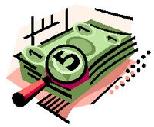
 |
|
| Financial Terms | |
| Spectail |
|
Information about financial, finance, business, accounting, payroll, inventory, investment, money, inventory control, stock trading, financial advisor, tax advisor, credit.
Main Page: inventory, accounting, investment, payroll, money, credit, financial, stock trading, |
Definition of Spectail
SpectailA dealer that does business with retail but that concentrates more on acquiring and financing its own
Related Terms:Asset-based financingMethods of financing in which lenders and equity investors look principally to the Back-to-back financingAn intercompany loan channeled through a bank. Basic business strategiesKey strategies a firm intends to pursue in carrying out its business plan. Bridge financingInterim financing of one sort or another used to solidify a position until more permanent Builder buydown loanA mortgage loan on newly developed property that the builder subsidizes during the Business cycleRepetitive cycles of economic expansion and recession. Business failureA business that has terminated with a loss to creditors.  Business riskThe risk that the cash flow of an issuer will be impaired because of adverse economic BuydownsMortgages in which monthly payments consist of principal and interest, with portions of these Cost of lease financingA lease's internal rate of return. CramdownThe ability of the bankruptcy court to confirm a plan of reorganization over the objections of Crown jewelA particularly profitable or otherwise particularly valuable corporate unit or asset of a firm. DealerAn entity that stands ready and willing to buy a security for its own account (at its bid price) or sell Dealer loanOvernight, collateralized loan made to a dealer financing his position by borrowing from a Dealer marketA market where traders specializing in particular commodities buy and sell assets for their Dealer optionsOver-the-counter options, such as those offered by government and mortgage-backed  Debtor-in-possession financingNew debt obtained by a firm during the Chapter 11 bankruptcy process. Down-and-in optionBarrier option that comes into existence if asset price hits a barrier. Down-and-out optionBarrier option that expires if asset price hits a barrier. DowngradeA classic negative change in ratings for a stock, and or other rated security. Employee stock ownership plan (ESOP)A company contributes to a trust fund that buys stock on behalf of Federal Financing BankA federal institution that lends to a wide array of federal credit agencies funds it Financing decisionsDecisions concerning the liabilities and stockholders' equity side of the firm's balance Foreign exchange dealerA firm or individual that buys foreign exchange from one party and then sells it to Limitation on asset dispositionsA bond covenant that restricts in some way a firm's ability to sell major assets. Multi-option financing facilityA syndicated confirmed credit line with attached options. Net financing costAlso called the cost of carry or, simply, carry, the difference between the cost of financing Odd lot dealerA broker who combines odd lots of securities from multiple buy or sell orders into round lots Off-balance-sheet financingfinancing that is not shown as a liability in a company's balance sheet. PaydownIn a Treasury refunding, the amount by which the par value of the securities maturing exceeds that Planned financing programProgram of short-term and long-term financing as outlined in the corporate Production payment financingA method of nonrecourse asset-based financing in which a specified RetailIndividual and institutional customers as opposed to dealers and brokers. Retail creditCredit granted by a firm to consumers for the purchase of goods or services. Retail investors, individual investorsSmall investors who commit capital for their personal account. Speculative demand (for money)The need for cash to take advantage of investment opportunities that may arise. Speculative grade bondBond rated Ba or lower by Moody's, or BB or lower by S&P, or an unrated bond. Speculative motiveA desire to hold cash for the purpose of being in a position to exploit any attractive Threshold for refinancingThe point when the WAC of an MBS is at a level to induce homeowners to Top-down equity management styleA management style that begins with an assessment of the overall Write-downDecreasing the book value of an asset if its book value is overstated compared to current market values. CASH FLOWS FROM FINANCING ACTIVITIESA section on the cash-flow statement that shows how much cash a company raised by selling stocks or bonds this year and how much was paid out for cash dividends and other finance-related obligations. STOCKHOLDERS’ (OR OWNERS’) EQUITYThe value of the owners’ interests in a company. financing activitiesOne of the three classes of cash flows reported in the inventory write-downRefers to making an entry, usually at the close of a owners' equityRefers to the capital invested in a business by its shareowners business intelligence (BI) systema formal process for gathering and analyzing information and producing intelligence to meet decision making needs; requires information about business process reengineering (BPR)the process of combining information technology to create new and more effective business-value-added activityan activity that is necessary for the operation of the business but for which a customer would not want to pay downsizingany management action that reduces employment Employee Stock Ownership Plan (ESOP)a profit-sharing compensation program in which investments are made in financing decisiona judgment made regarding the method Internet business modela model that involves Owners' equityThe total of all capital contributions and retained earnings on a business’s financing decisionDecision as to how to raise the money to pay for investments in real assets. operating risk (business risk)Risk in firm’s operating income. Business CycleFluctuations of GDP around its long-run trend, consisting of recession, trough, expansion, and peak. DealerA person or firm in the financial asset business who buys for his or her own account and then resells to customers, in contrast to a broker, who buys only on behalf of a customer. Political Business CycleA business cycle caused by policies undertaken to help a government be re-elected. Real Business Cycle TheoryBelief that business cycles arise from real shocks to the economy, such as technology advances and natural resource discoveries, and have little to do with monetary policy. Employee Stock Ownership Plan (ESOP)A fund containing company stock and owned by employees, paid for by ongoing contributions by the employer. Cash Flow Provided or Used from Financing ActivitiesCash receipts and payments involving Write-DownA reduction in the balance-sheet valuation of an asset with an accompanying Contingent OwnerThis is the person designated to become the new owner of a life insurance policy if the original owner dies before the life insured. OwnerThis is the person who owns the insurance policy. It is usually the same person as the insured but it could be someone else who has the permission of the insured to be the owner, like a spouse, a common-law-spouse, an offspring, a parent, a corporation with insurable interest or a business partner with insurable interest. In order for someone else to be an owner of your policy, they have to have a legitimate insurable interest in you. Asset-Based FinancingLoans granted usually by a financial institution where the asset being financed constitutes the sole security given to the lender. Business Expansion InvestmentThe use of capital to create more money through the addition of fixed assets or through income producing vehicles. Debt FinancingRaising loan capital through the creation of debt by issuing a form of paper evidencing amounts owed and payable on specified dates or on demand. Export FinancingA range of financing products (loans. guarantees, letters of credit, insurance etc.) in support of a variety of activities which help Canadian firms expand into new export markets. Financing InstrumentsThis is a generic term that refers to the many different forms of financing a business may use. For example - loans, shares, and bonds are all considered financing instruments. High-Risk Small BusinessFirm viewed as being particularly subject to risk from an investors perspective. Project FinancingDebt finance, usually non-recourse, provided by financial institutions for the development and construction of a new project. Seed Financing/CapitalGenerally, refers to the first contribution of capital toward the financing requirements of a start-up business. Commercial Business Loan (Credit Insurance)An agreement between a creditor and a borrower, where the creditor has loaned an amount to the borrower for business purposes. PolicyownerThe person who owns and holds all rights under the policy, including the power to name and change beneficiaries, make a policy loan, assign the policy to a financial institution as collateral for a loan, withdraw funds or surrender the policy. Refinancing (Credit Insurance)Extending the maturity date or increasing the amount of existing debt or both. Also, revising a payment schedule, usually to reduce the monthly payments and often to modify interest charges. Related to : financial, finance, business, accounting, payroll, inventory, investment, money, inventory control, stock trading, financial advisor, tax advisor, credit. |